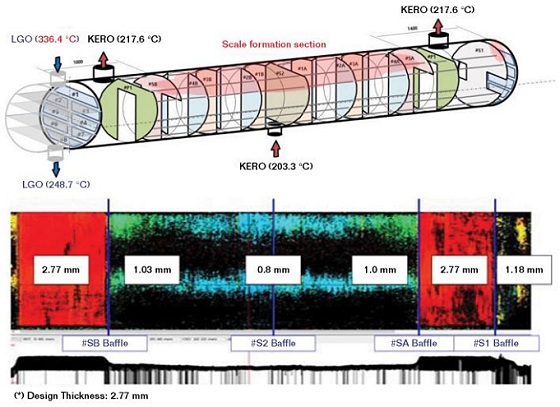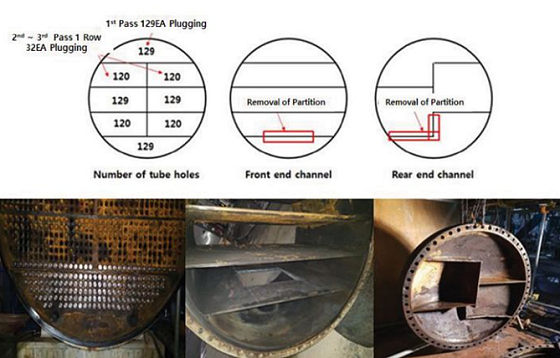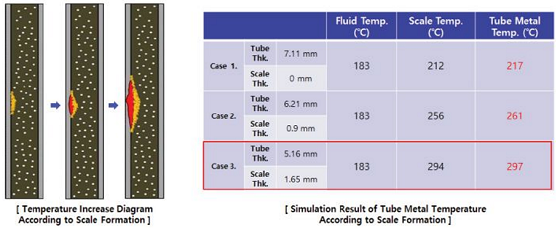Refineries have long experienced damage from high-temperature sulfidation, one of the most well-known damage mechanisms in the refining industry. It is known to occur in crude distillation units, vacuum distillation units, and hydroprocessing units, and typically at temperatures of 200 °C or more. This type of corrosion can also result in an explosion when there is a leak.
To mitigate problems related to high-temperature sulfidation in refineries, suitable materials must be used, along with operating the equipment within the specified temperature range. Equipment should also be inspected and replaced at designated timeframes.
Unfortunately, some accidents are not well understood. Researchers are making an effort to better understand these phenomena. Hyungjin Lee, et al., with SK Inchon Petrochem, SK Innovation, and SK Energy (Republic of Korea), are working to identify the causes of these incidents more accurately through accident investigation and internal research. This article will examine three cases studies covering high-temperature sulfidation failures.
Case Study 1
This case study looks at a heat exchanger tube leakage caused by accelerated corrosion from changes to operating condition and scale deposits in a process condition with high reactive sulfur content. The leak occurred only five years after installation of the equipment and took place in the kerosene splitter reboiler of the condensate distillation unit.

Installed in 2014, the equipment first underwent open maintenance in 2016, when it was discovered that internal and external corrosion existed. From these findings, it was estimated to have about 3.6 years of life remaining; however, the leak occurred sooner than the experts predicted.
The researchers were able to isolate and open the heat exchanger, which revealed severe corrosion in the first pass tubes. It is important to note that no corrosion occurred without scale deposits. Figure 1 shows a reduction in thickness to the center portion of the tube on the outside where the scale was located.
Because water cannot easily occur in areas of high temperature, these areas often contain high-temperature sulfidation and naphthenic acid corrosion. Naphthenic acid corrosion is not suspected because the oils processed were low in total acid number. When naphthenic acid corrosion takes place, there is either iron oxide (Fe2O3) under the iron sulfide (FeS) scale or if there is a strong flow, there is an absence of scale. In this case study, however, only FeS scale was confirmed. Therefore, high-temperature sulfidation is presumed.
Exchange of all retubing was necessary, and because of cost, it was determined that remodeling the bundle would be the best option. Figure 2 shows that the tubes were plugged.

After the maintenance that took place in 2016, it was discovered that the temperature of the hot side fluid in the kerosene stripper reboiler had averaged 12 °C (and a maximum of 30 °C) higher than it had been previously. Simulations also concluded that the tube metal temperature after the 2016 maintenance was 10 to 15 °C higher than before. Additionally, no change to throughput and feed types occurred. All this indicates that the increase of the corrosion rate is due to the increase in operating temperature.
Case Study 2
In the second case study, the facility was installed in 1991, and an inspection was completed in 2016 via intelligent pig ultrasonic testing. Testing revealed the need to replace the elbow single tube because it no longer met the required thickness, which was completed. Furthermore, the crossover tube running from the radiation section to the convection section was scheduled for replacement in 2019.
Only five months prior to scheduled maintenance, the leak occurred in the naphtha splitter reboiler. Corrosion was found to be most aggressive at the 12 o’clock position of the leak-producing tube. FeS scale—a high-temperature sulfur damage mechanism—was found internally. Researchers were able to verify that the corrosion mechanism was high-temperature sulfidation resulting from internal scale.
The rapid increase in the corrosion rate was found to be caused by an increase in the mixing ratio of the crude oil (that has high reactive sulfur) and an increase in operation severity (compared to prior use). The crude distillation unit was initially treating heavy crude, which contained a lower sulfur content, but then later switched to light oil types, which contain much more sulfur.
The temperature of the crossover tube—the location of the leak—increased from 226 to 267 °C, resulting in harsher operating conditions than in the past.
This increase in temperature can be attributed to increased heater duty. As the temperature increased, so did the severity of the operating conditions. Ultimately, the fired heater was replaced with a steam reboiler type, removing the possibility of high-temperature sulfidation during the next turnaround.
Case Study 3
A month after the leak in the naphtha reboiler heater from Case Study 2, another leak took place, this time in a radiant section tube of the stabilizer reboiler heater in the light end recovery unit. The leak was in the fireside exposed to high temperature. The cause of the leak was due to high-temperature sulfidation corrosion from internal scale, as shown in Figure 3.

Similar to Case Study 2, the corrosion rate increased dramatically in the area of the leak as compared to past rates. Again, this can be attributed to the treatment of light crude and condensate oil rather than heavy crude treatment processed in the past.
Although the operating temperature of the fired heater is not consistent with the normal high-temperature sulfidation occurrence conditions (180 °C), because the liquid films are thinned, the temperature of the tube metal is increased by the internal flame.
Consequently, it is more susceptible to high-temperature sulfidation. It is believed that high tube metal temperature with FeS scale was present, and predictions indicate the maximum level was ~290 °C. At this temperature, the corrosion rate is believed to have quickly increased (Figure 4).
As opposed to Case Study 2, this incident displayed an increased corrosion rate at a specific location, thought to be from the liquid film formed on the inner wall of the tube, which changed the fluid from a slug flow to a bubbly flow and resulted in the liquid becoming vaporized.
During the 2019 turnaround, the entire tube was replaced and by changing the operating conditions and allowing the internal liquid film to operate thickly, thus by increasing the flow rate, the high-temperature sulfidation was reduced.

Conclusion
Data analysis of these three case studies reveals that the corrosion rate of hightemperature sulfidation can be accelerated by increasing the temperature merely 10 °C or changing the flow regime in a fired heater when the process stream contains vulnerable sulfur species (e.g., sulfide, disulfide, and mercaptan in kerosene and naphtha streams).
A correlation between corrosion rate and temperature was analyzed by conducting autoclave tests and even when the operating temperature is not in a range where sulfidation would be expected, under conditions of local overheating, it was found that high-temperature sulfidation corrosion can be severe.
This article is based on CORROSION 2021 paper no. 16738, presented virtually.